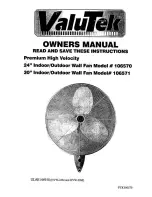
9
"CG3" SERIES VENTILATOR PRINCIPLE OF OPERATION
TESTING INTERNAL FIRE MODE –
FOR CG3 AND CG3-FDT ONLY!
The internal fire protection system may be tested periodically
by pushing and holding for 20 seconds, the “Fire Test
Switch” located inside the electrical compartment of the
control cabinet. Pushing this switch duplicates thermostatic
action.
CAUTION: Before pushing the “Fire Test Switch”,
check to see if the internal fire protection system is tied to the
building alarm system.
TO RESUME NORMAL OPERATION
1.
To discontinue the 2 minute cool down cycle at any point
during the cycle, push the “Exit” F5 button on the C-6000
Command Center.
2.
Push the “Start Fan” F1 button on the Command Center.
SURFACE FIRE PROTECTION
The National Fire Protection Association, NFPA-96 document
requires fire extinguishing equipment over all grease producing
cooking equipment such as griddles, ranges, fryers, broilers,
and woks. In addition, the system must protect the interior of
the ventilator and the exhaust duct.
The most common fire system is either a wet chemical type
or the Gaylord Quencher water spray system. In the event of
a fire this system would normally be activated and discharged
prior to the ventilator’s internal fire protection. If the fire is
unusually severe or the surface fire protection system malfunc-
tions, the ventilator’s internal fire protection system would
activate, thus providing a second level of defense. These
systems may be intertied with the ventilator control cabinet to
activate the External Fire Mode.
FIG. 5
BREAK GLASS FIRE SWITCH
C-1357A SERIES
EXTERNAL FIRE MODE
An External Fire Mode is activated by the Ventilator’s Fire
Suppression (Duct, Plenum, Surface/Appliance) system’s
microswitch or contacts and/or an optional break glass fire
switch (see Figure 5). Terminals 4 & FS are used for the
External Fire Mode, refer to wiring diagram for details. The
break glass fire switch, if used, would normally be located at
the exit of the kitchen. When the External Fire Mode is
activated, the following occurs:
1.
The Exhaust Fan comes on immediately if it was off to help
remove smoke, heat, etc.
2.
The Supply Fan shuts off immediately.
3.
The digital display reads “Ext.FireActive” and alternates
between “Reset FireSwitch” and “Fan On, Wash On”.
4.
A red light on the Command Center flashes.
5.
After a 60-second delay, a fire smothering water spray is
released into the interior of the ventilator through the spray
nozzles. The 60-second delay allows the ventilator’s fire
suppression system time to put out the fire, before starting
the water spray.
If the fire intensifies and the thermostat reaches 250°F, the fire
damper would then close and the exhaust fan would shut off.
See Internal Fire Mode.
To resume normal operations, open the fire switch and flip the
toggle switch to the position marked “normal”. Replace the
glass rod and close the cover. Push either the “Start Fan” or
“Start Wash” button.
INTERNAL & EXTERNAL FIRE MODES AT THE SAME TIME
It is possible that both the Internal and External Fire modes can
be activated at the same time. If this occurs, the Internal Fire
Mode will override the External Fire mode until the thermostat(s)
cool below 250°F. At this point the Cool Down Cycle will start
counting down for 2 minutes. After the Cool Down Cycle, the
External Fire mode will start.
Special Note: If the control is in the Cool Down Cycle
when the External Fire mode is activated, the Cool
Down Cycle will finish counting down for 2 minutes,
before switching to the External Fire Mode.
Summary of Both Fire Modes at the Same Time
1.
Internal Fire Mode (until thermostat temperature drops
below 250°F)
2.
Cool Down Cycle (for 2 minutes)
3.
External Fire Mode (until the External Fire Switch is
reset)
FIRE MODE SUMMARY:
Note: The Damper Position does not apply to CG3-FDL, CG3-
FDD, or CG3-ND
INTERNAL
FIRE
COOL DOWN CYCLE
(for Internal Fire
Mode only!)
EXTERNAL
FIRE
Exhaust Fan
OFF
OFF
ON
Supply Fan
OFF
OFF
OFF
Damper Position
FIRE
EXHAUST
EXHAUST
Water Spray
ON
ON
ON
Summary of Contents for C-6000 Series
Page 5: ...5 CG3 VENTILATOR DESCRIPTIONS ...
Page 40: ...40 DETERGENT PUMP ...
Page 42: ...42 WIRING DIAGRAM FOR MODEL C 6000 10 120 VOLT ...
Page 43: ...43 WIRING DIAGRAM FOR MODEL C 6000 10 220 VOLT ...
Page 44: ...44 WIRING DIAGRAM FOR MODEL C 6000 10 A 120 VOLT ...
Page 45: ...45 WIRING DIAGRAM FOR MODEL C 6000 10 A 220 VOLT ...
Page 46: ...46 WIRING DIAGRAM FOR MODEL C 6000 10 B 120 VOLT ...
Page 47: ...47 WIRING DIAGRAM FOR MODEL C 6000 20 B 120 VOLT ...
Page 48: ...48 WIRING DIAGRAM FOR MODEL C 6000 10 B 220 VOLT ...
Page 49: ...49 WIRING DIAGRAM FOR MODEL C 6000 20 B 220 VOLT ...










































